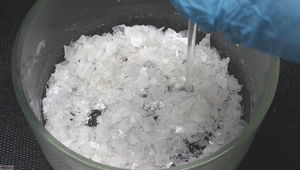Difference between revisions of "Silver nitrate"
| Line 173: | Line 173: | ||
[[Category:Solids]] | [[Category:Solids]] | ||
[[Category:Essential reagents]] | [[Category:Essential reagents]] | ||
| + | [[Category:Irritants]] | ||
Revision as of 21:09, 5 July 2017
 Dry silver nitrate crystals
| |
| Names | |
|---|---|
| IUPAC name
Silver nitrate
| |
| Preferred IUPAC name
Silver nitrate | |
| Systematic IUPAC name
Silver nitrate | |
| Other names
Argenti nitras
Lunar caustic Nitric acid silver(I) salt Silver(I) nitrate | |
| Properties | |
| AgNO3 | |
| Molar mass | 169.87 g/mol |
| Appearance | White solid |
| Odor | Odorless |
| Melting point | 209.7 °C (409.5 °F; 482.8 K) |
| Boiling point | 440 °C (824 °F; 713 K) (decomposes) |
| 122 g/100 mL (0 °C) 170 g/100 mL (10 °C) 256 g/100 mL (25 °C) 373 g/100 mL (40 °C) 912 g/100 mL (100 °C) | |
| Solubility | Soluble in ammonia, diethyl ether, glycerol |
| Solubility in acetic acid | 0.0776 g/100 g (30 °C) 0.1244 g/100 g (40 °C) 0.5503 g/100 g (93 °C) |
| Solubility in acetone | 0.35 g/100 g (14 °C) 0.44 g/100 g (18 °C) |
| Solubility in benzene | 0.022 g/100 g (35 °C) 0.044 g/100 g (40.5 °C) |
| Solubility in ethanol | 3.1 g/100 g (19 °C) |
| Solubility in ethyl acetate | 2.7 g/100 g (20 °C) |
| Viscosity | 3.77 cP (244 °C) 3.04 cP (275 °C) |
| Thermochemistry | |
| Std molar
entropy (S |
140.9 J·mol-1·K-1 |
| Std enthalpy of
formation (ΔfH |
−124.4 kJ/mol |
| Hazards | |
| Safety data sheet | FisherScientific |
| Flash point | Non-flammable |
| Related compounds | |
| Related compounds
|
Silver sulfate |
| Except where otherwise noted, data are given for materials in their standard state (at 25 °C [77 °F], 100 kPa). | |
| Infobox references | |
Silver nitrate is a chemical compound, salt of nitric acid and silver metal. It has the chemical formula AgNO3.
Contents
Properties
Chemical
Silver nitrate can be reduced to elemental silver, in the presence of a reducing agent, such as ascorbic acid.
Silver nitrate decomposes when heated at 440 °C.
- 2 AgNO3 → 2 Ag + O2 + 2 NO2(g)
Physical
Silver nitrate is an odorless white salt (older samples may appear gray). Unlike silver perchlorate, it is not hygroscopic. It is soluble in water, acetone, ether.
Availability
Silver nitrate can be purchased from pharmacies, usually as a solution or as sticks, known as "caustic pencils". In some countries, these pencils contain a mixture of silver and potassium nitrates. It can also be purchased in solid form, from chemical suppliers.
Preparation
Silver nitrate can be prepared by reacting nitric acid with silver metal. Heating the acid accelerates the reaction.
Projects
- Make silver acetate
- Silver carbonate synthesis
- Make silver mirror
- Ethyl nitrate synthesis
Handling
Safety
Silver nitrate can stain the skin as well as most objects and is toxic if swallowed. Gloves should be worn when handling the compound.
Contact with ethanol will cause explosion.
Storage
Silver nitrate should be kept in closed bottles, in dark places, such as a cabinet, as it is sensitive to light. Avoid storing it close to volatile reducing agents.
Disposal
Silver nitrate should be reduced to elemental silver, which can be recycled.